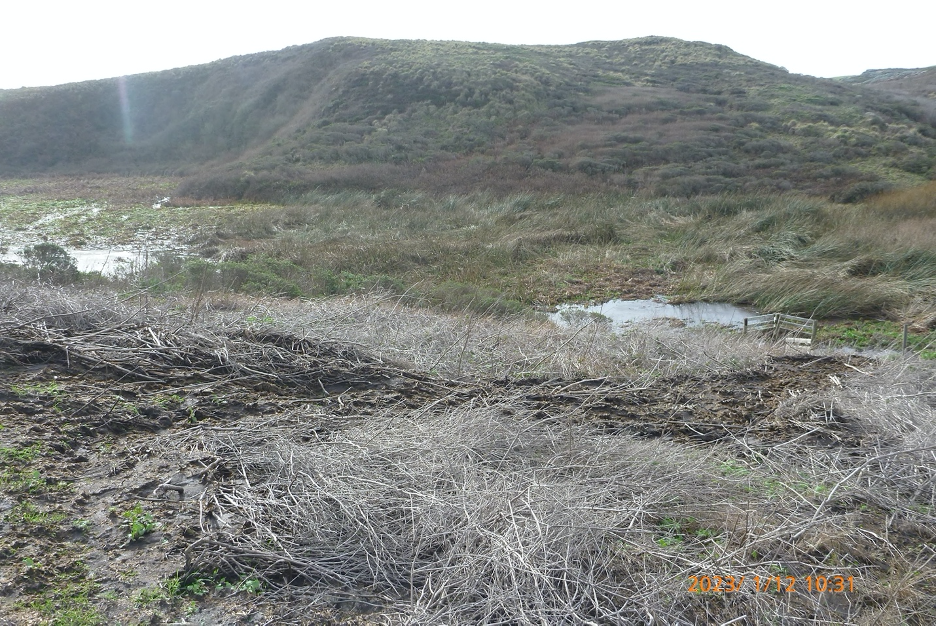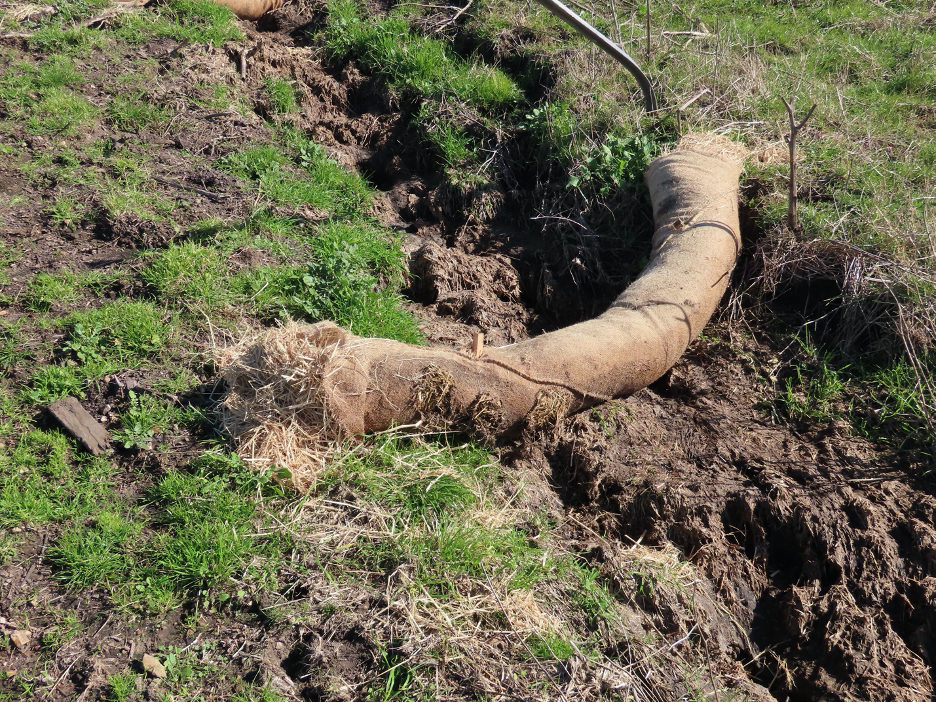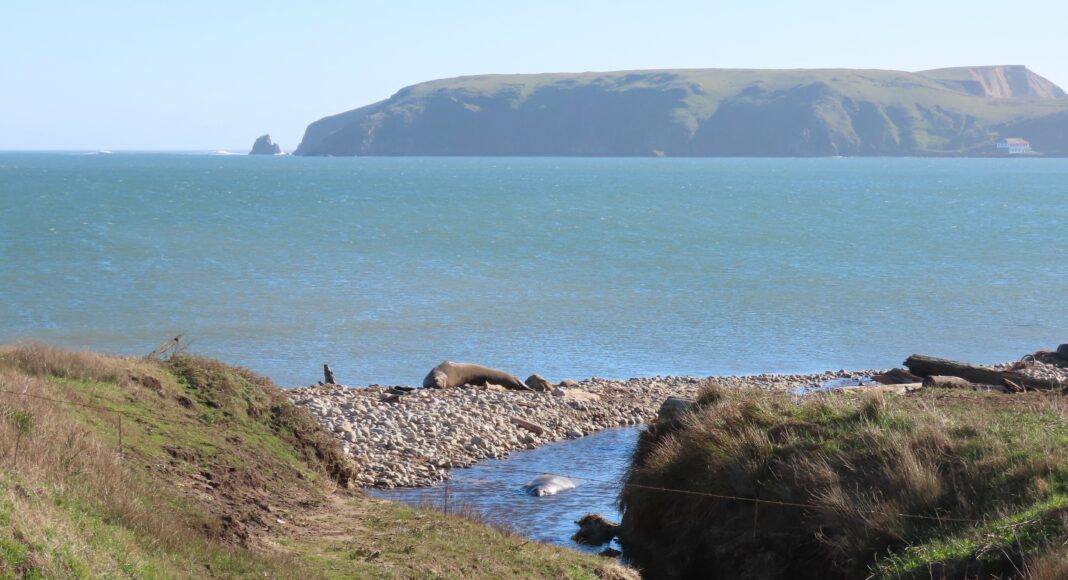January storms lashed a hilltop cattle feedlot at J Ranch in Point Reyes National Seashore. Tons of E. coli, ammonia, and nitrogen laden manure liquified and flooded downhill across a popular hiking trail, splashing into Kehoe Creek, which drains into the Pacific Ocean.
A hiker photographed the catastrophe and emailed the evidence to Park Superintendent, Craig Kenkel, and regional Water Quality Control Board manager, Xavier Fernandez.


The Park Service ordered J Ranch lessees, Tim, Tom and Mike Kehoe to limit the damage. The ranchers staked a dozen burlap tubes stuffed with straw across gullies cut by the manured storm waters. In an email, Fernandez characterized the tubes as “erosion and sediment control measures.”

Neither Fernandez, Kenkel, nor the ranchers commented on why the mass of manure abutting a cow feeding trough was allowed to be uncontained. Seashore ranch leases and environmental regulations prohibit pollution of waterways from agricultural activities.
Fernandez initially told this newspaper, “The Park Service conducted their first week of bacteria samples during this time, and there were no indications that excess sediment or manure was directly discharged to [Kehoe] creek.” Responding to a request for the water testing data, Fernandez replied, “I have a correction to make. We do not have data from the Park Service from the monitoring that they conducted during storms in January.”
Kenkel did not respond to requests for the testing data.
Manure Thickens, Seals Die
Recent water quality tests sponsored by Turtle Island Restoration Network reveal life-harming levels of fecal bacteria and other agricultural waste in Kehoe Creek and throughout the park. Ten miles south of Kehoe Creek, these tests registered excessive concentrations of life-harming bacteria, ammonia, nitrogen and phosphorus in waters streaming through B Ranch cow pastures onto a plastic and construction debris-strewn beach on Drakes Bay. During January, the beach and stream were inhabited by pregnant elephant seals; the mammals have migrated to Drakes Bay beaches to give birth since time immemorial.

In a statement prepared for this newspaper, Greg Sarris, chairperson of the Federated Indians of the Graton Rancheria, which co-manages the park, observed, “The seals are being sickened, and even dying, as a result of excess manure flowing to their habitats.”
Sarris suggested, “The dairymen might consider building a fence to keep the seals from areas greatly affected by the pollution flow.”
On Jan. 25, Rep. Jared Huffman sent a letter to Kenkel supporting Park Service “measures to prevent the seals from hauling out or pupping in areas where there is a need to remediate water quality problems, and measures to temporarily prevent cattle from grazing in areas where the seals are present.”
Neither Sarris nor Huffman nor Kenkel nor Fernandez explained how many seals are sick and dying, nor how building more fences would help them. The agricultural pollution of the water table at B Ranch and throughout Point Reyes goes back decades; these flows cannot be stopped by wire fences. B Ranch has a history of dumping human sewage into the pastures.
Noaki Schwartz, spokesperson for the California Coastal Commission, another agency with jurisdiction over the Seashore, commented, “We were all surprised and frankly disgusted to hear about the discharge of agricultural waste into sensitive marine areas and have been looking into everything we can do to address it and prevent it from happening again. We are actively engaging with all the agencies with a relevant regulatory role to play in these areas and have spent the past week coordinating with them to figure out how best to proceed, both in the immediate and long term,” Schwartz stated.
In a Feb. 3 letter to Huffman, Kenkel stated, “The elephant seal use of Drakes Beach has dramatically increased in the last seven years, bringing the seals into contact with areas below active dairies.”
In an email to this newspaper, the Marine Mammal Center noted, “Proposed next steps include ongoing surveillance of pups at Point Reyes National Seashore for the presence of pathogens and antimicrobial resistance that may be linked to exposure to agricultural runoff or other anthropogenic factors.”
According to Joseph Sanchez, an elder of the Coast Miwok Tribal Council of Marin, “The degradation of the land, and officialdom’s disregard for the ecology of Point Reyes National Seashore, has been going on since the ranchers were paid millions of dollars to leave in the 1970s and did not leave. The elephant seals were here long before our ancestors, who were caretakers of the land. The streams were clear, and the salmon were running. The Tribal Council advocates for restoring Point Reyes to its native state without the presence of ranching.”
In 2020, a National Park Service environmental study determined that “impacts on water quality would be noticeable, long term, and beneficial” by eliminating ranching from the grossly polluted Seashore park.
Nevertheless, the Park Service, with Huffman’s legislative support, is attempting to subsidize and expand the reach of environmentally destructive cattle and dairy ranching at Point Reyes, even though the general public and many scientists are strongly opposed. The Park Service is currently mediating a lawsuit brought by three national environmental groups petitioning to protect endemic wildlife and plants by removing ecologically harmful private ranching businesses from the Park.
FEB. 7, 2023 EDITOR’S NOTE: This story has been updated to reflect new information since it was first published online.












really, why don’t they exclude the cows and leave the seals to do what they have been doing all along. it’s that biased attitude prioritizing ranching to the detriment of native wildlife and wilderness. shameful
AGREE!
The answer is clear. The ranches must go! Private for-profit cows do not belong in a National Seashore, the most highly protected park designation we have.
AGREE!
Point Reyes allows elk to starve and elephant seals to swim in contaminated water and die, all to please for-profit beef and dairy operators. This is not what National Parks are for.
I couldn’t agree more!
Fencing in the seals because of the pollution is like locking people in their houses because of crime on the streets. You remove the criminals, not the residents.
Thank you for continuing to expose the environmental destruction caused by ranching. If this can be allowed to happen in a National Park, where profits of the dairy and meat industry take precedence over wildlife and the environment, imagine how much worse it is everywhere else.
The CCC saying they are surprised is one of the most ridiculous things I’ve heard in this whole fiasco (and it’s a strong field.) They received 45,000 letters and scores of hours of public testimony (not to mention a citizen funded water quality study) telling them exactly that. That’s either a lie or a staggering admission that they’ve been only pretending to do their jobs for the last several years. Maybe Ms. Schwartz is new, in which case she should not have been responding as a spokesperson.
How many times do we, the people, have to buy out the ranchers to get these invasive cattle out, to make the National Seashore safe for indigenous aquatic species, seashore mammals and the tule elk that I love to see.
How many times indeed!
More excellent work from Peter Byrne! Good to see Greg Sarris showing concern, although his suggestion isn’t a practical solution. But since the Graton Rancheria has a co-government relationship with the Park Service, maybe that will help NPS get off it’s ass and do something to protect the environment in Pt. Reyes instead of acting as the handmaiden to the for-profit ranching industry that is despoiling our park! And I wouldn’t be too hard on the CCC spokesperson. At least they’re saying they’re going to do something. That’s more than the Park Service or the Water Board.
This doesn’t seem like rocket science. The evidence continues to mount showing the detriment ranching in Point Reyes is having on the environment and its inhabitants. How many animals have to die, how many times does the water have to be tested to show the negative impact ranching has, how many documentaries showing the environmental issues have to be made, how many constituents have to rise up and say enough is enough?!! It’s time to do what’s right and rid Point Reyes of ranching.
AGREE!
As a 10-year elephant seal docent as PRNS, I can attest to the fact that the seals rest in their own scat for months, as is evident by anyone standing downwind from the colony. There is no evidence of seal mortality from their own scat nor from the cattle run off. I believe this story creates a false cause-effect relationship by conflating two unrelated circumstances: run off from a ranch creek and a seal pup die off due to storm pushed high tides (which happens every year or so).
Runoff to creeks, bays and oceans from PRNS ranches must stop, but, as with stopping the storm induced municipal sewage overflows to SF Bay, there are two solutions: one is to evict the people/animals creating the sewage…the other is to fix the treatment plant. If ranches are going to stay at PRNS, cattle need to be fenced out of creeks with wildlife-friendly fencing and treatment of diary waste needs to be done by composting rather than with waste ponds that overflow in storms…and the elk fence should come down.
There is no such thing as “wildlife friendly fencing.”
Correction Mr. Sanchez: More than 20 ranches were purchased and made into national parklands in 1962 by the Kennedy administration. The federal government leased back the land to the ranchers at that point. They were not “paid to leave”
Judy is correct. The fact that Pt Reyes ranchers were paid Fair Market Value for their private land needed to create the National Seashore has been twisted by opponent of ranching at Pt Reyes into a claim that Pt Reyes ranchers were ”paid to leave.” They were not.
Pt Reyes was one of the first parks created by buying private land (vs converting already owned public land) and the Park Service did not want to set a bad precedent by forcing private owners to sell, so Pt Reyes ranchers had to be “willing” sellers. But Fair Market Value alone does not necessarily make a seller “willing.”
Imagine that you lived in a home that your grandfather built, you were born and raised in and raised your children in…but the government wanted to buy it to use the back yard. Would offering you Fair Market Value make you a willing seller? With all those personal memories your response to the government offer would probably be: “I’m not willing.” But what if the government said, we’ll pay you Fair Market Value AND you can continue living in your home…we’ll lease it back to you. That offer of continued use in ADDITION to Fair Market Value might be enough to make you a “willing” seller.
That was the same situation with the Pt Reyes ranchers, who were offered Fair Market Value AND the ability to continue leasing the land…enough to make Pr Reyes ranchers into “willing sellers.” Kicking Pt Reyes ranchers out would renege on the deal offered to make them “willing” sellers, which would make future Park Service purchases of private land much more difficult. Kicking Pt Reyes ranchers out would also not solve the pollution problem, but instead would simply outsource the cattle and their pollution to less regulated areas.
But that offer to Pt Reyes ranchers to continue ranching is not a license for anything goes…especially not polluting creeks. If the Pt Reyes ranchers want to stay, they are going to have to get very serious about substantially cleaning up their act. This clean-up is not rocket science, but it does require investment. Fencing cattle out of creeks (as recommended by the CA Water Quality Control Board) with wildlife-friendly fencing will eliminate much of the creek pollution. Moving to composting dairy waste (as recommended to the CA Air Resources Board) instead of washing waste into ponds (that create greenhouse gas and overflow in big storms) would eliminate the rest of the creek pollution.
Let’s be historical: Were the Coast Miwok paid Fair Market Value for the lands upon which the National Park Service and its federally subsidized, super-polluting rent-a-ranches squat?
Wouldn’t that deal have been sweet for the Miwok, in a small Pt Reyes National Seashore area where they didn’t need to “imagine” that their grandparents lived and worshiped at this sacred site of theirs.
Their history and current struggle is simply and beautifully described in an article by High Country News: https://www.hcn.org/articles/indigenous-affairs-land-Coast-Miwok-family-fight-for-recognition-at-Point-Reyes
Also, it’s strange to hear the claim that “kicking out ranchers” will “outsource the cattle and their pollution to less regulated areas” this implies that: 1) We have adequate regulation at Point Reyes National Seashore, and 2) That raising cattle must need create pollution, and 3) That farmers and ranchers on these other “outsourced” sites would not be good stewards of the environment and their cows.
Some (not all) of Point Reyes National Seashore ranchers, pollute irresponsibly, and cause extreme damage to this coastal land. I don’t believe these have earned a place in the precious gem that is Point Reyes National Seashore.
Jared Hoffman has been a key player in allowing the ranchers’ plan to obviate the terms of their contract and while also continuing to pollute the Pt. Reyes seashore. Overwhelming numbers in opposition to the park service plan have not brought Mr. Hoffman to state a clear position of opposition and action to serve the public’s will. Weakness in the face of powerful farming interests!